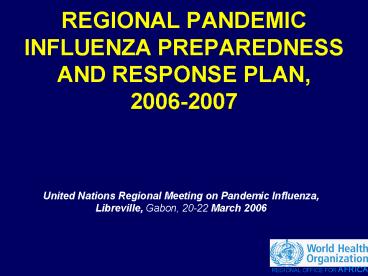REGIONAL PANDEMIC INFLUENZA PREPAREDNESS AND RESPONSE PLAN, 20062007 - PowerPoint PPT Presentation
1 / 16
Title:
REGIONAL PANDEMIC INFLUENZA PREPAREDNESS AND RESPONSE PLAN, 20062007
Description:
... Germany, France, Rumania, Iraq, etc.) have reported cases of H5N1 in poultry ... Need to enhance the link between public health, veterinary and wildlife services ... – PowerPoint PPT presentation
Number of Views:43
Avg rating:3.0/5.0
Title: REGIONAL PANDEMIC INFLUENZA PREPAREDNESS AND RESPONSE PLAN, 20062007
1
REGIONAL PANDEMIC INFLUENZA PREPAREDNESS AND
RESPONSE PLAN, 2006-2007
- United Nations Regional Meeting on Pandemic
Influenza, - Libreville, Gabon, 20-22 March 2006
2
I. Background II. Situation analysisIII.
Objectives . General Objective .
Specific Objectives IV. Expected Results and
related activities V. Critical factorsVI.
Monitoring and evaluation
OUTLINE OF THE PLAN
3
BACKGROUND (1)
- High risk of pandemic with human influenza
- Evidence has emerged of a zoonotic transmission
of avian influenza virus H5N1 - H5N1 virus is now endemic in parts of Asia
- Number of countries in Asia and Europe (Turkey,
Germany, France, Rumania, Iraq, etc.) have
reported cases of H5N1 in poultry - So far, number of countries in Asia and Europe
(Turkey) have reported Human cases of H5N1 - Africa has reported cases due to H5N1 among while
and domestic birds in Nigeria, Egypt, Niger, and
Cameroon and one human case recently in Egypt
4
Member States of the WHO African Region are
currently not well prepared for influenza
pandemic
BACKGROUND (2)
- This presentation highlights the key issues that
need to be addressed for a coordinated regional
response to the pandemic
5
Surveillance systems need to be further
strengthened to timely detect suspected cases
with symptoms similar to influenza like
illnesses
SITUATION ANALYSIS (1)
- Sentinel surveillance for influenza is on going
in a limited number of countries
- Need to enhance the link between public health,
veterinary and wildlife services
- The implementation of Integrated Disease
Surveillance and Response (IDSR) offers an
opportunity for a better preparedness and
response to possible influenza pandemic
6
The African region has developed experience and
expertise in operations for accelerated disease
control initiatives
SITUATION ANALYSIS (2)
- Existing laboratory networks offer a model
around which virological surveillance for
influenza can be strengthened within the region
- Most countries in the region have established
national epidemic management and coordination
committees
- Some countries in the region have put in place
rapid response teams as recommended by WHO
- AFRO has put in place a regional adhoc Experts
panel on pandemic influenza
7
PROPOSED FLU LABORATORY NETWORK
IP- Algeria IP- Cote dIvoire IP- Senegal NICD-
South Africa IP- Madagascar IP- CAR CP-
Cameroon ENHRI- Ethiopia NMIMR-
Ghana Ibadan-Nigeria INRB- DRC KEMRI- Kenya UVRI-
Uganda UTH- Zambia
8
To contribute to the strengthening of national
and regional capacities on the preparedness and
response to pandemic Influenza in the WHO African
region
GENERAL OBJECTIVE
9
Reduce opportunities for human infection with
H5N1
SPECIFIC OBJECTIVES (1)
- To strengthen early warning systems
- To build capacity to cope with the pandemic
- To contain or delay spread at source
10
To enhance regional preparedness and response
coordination capacity
SPECIFIC OBJECTIVES (2)
- To strengthen national health systems to
effectively deal with diseases of epidemic and/or
pandemic potential
- To conduct operational research on human
pandemic influenza
11
Opportunities for human infection with H5N1
reduced
EXPECTED RESULTS (1)
- Early warning systems strengthened
- Capacity to cope with the pandemic Built
- Spread of Pandemic Influenza at source delayed
and contained
12
Regional preparedness and response coordination
enhanced
EXPECTED RESULTS (2)
- Research on human pandemic influenza conducted
- National health systems strengthened
- Communication and Health Promotion strengthened
13
Several activities to be undertaken over the next
2 years, have been identified in line with the
objectives and expected results
KEY ACTIVITIES
(Refer to Plan of Action)
14
Commitment and political will from all Member
States
CRITICAL FACTORS FOR SUCCESS
- Availability of resources at all levels
- Strong partnership among countries, partners
(including industries, research institutions and
donors)
15
MONITORING EVALUATION
- M E will be based on existing AFRO IDSR core
indicators
- Monitoring of inputs, processes and outputs
will be conducted daily till the end of the risk
- Evaluation of outcomes will be done quarterly
to assess the level of risk
16
Thank you for your attention































